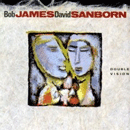 Classic, as defined by Webster, means: Classic, as defined by Webster, means:
(1) Being of the highest class or rank.
In 1986, Bob James and David Sanborn teamed up to make a CD called Double
Vision. With the help of powerhouse
musicians Al Jarreau, Marcus Miller, Steve Gadd, Paul Jackson,
Jr., Eric Gale and Paulinho Da Costa, Double Vision came
on the scene and made its mark in the contemporary jazz world. Back
in 1986, there was not yet a format with the label of smooth
jazz, but, unbeknownst to the two front musicians, they would
play a role in the origins of this new music format.
(2) Serving as an outstanding representative of a kind.
Double Vision continued the very
successful writing and playing collaboration of David Sanborn
and Marcus Miller. Marcus wrote two of the tracks on
this album, “More Than Friends” and the ever popular
hit “Maputo,” which still gets people on their
feet every time David Sanborn plays it in concert. Sanborn’s
alto sax comes out strong and steady. His passionate
playing is the perfect compliment to Bob James’ smooth
keyboards and synthesizers and Marcus Miller’s bass groove.
This style continues in the same fashion with “More Than
Friends.”
James and Sanborn wrote the aptly titled “Moon Tune.” The
playing on this song is intentionally a little off center. It
doesn’t have the melodic flow usually associated with something
of the smooth jazz genre. Nonetheless, it’s an interesting
piece of music.
On “Since I Fell For You,” Al Jarreau spices this
song up the way that only he can, singing and scatting his way
through this tune.
“Never Enough,” “It’s You, and “You
Don’t Know Me” showcases the talents of both James
and Sanborn. They each play their portions of these songs
with power and passion. It’s near the ends of these
songs that the heat gets turned up and you can hear just how
great these two musicians really are together.
In 1986, I was just beginning to discover this genre of music. I
listened to bits and pieces of contemporary, and what would become
known as smooth, jazz but this CD marked the true beginning of
a journey that continues to this day. It was no accident
that Double Vision was my first jazz
purchase. I knew the name David Sanborn. I knew the
name Bob James. Their music could often be heard on radio
station WRVR in the rooms of our family home. I trusted
those names when I made my very first search of the music store
for jazz.
(3) Having lasting significance or recognized worth.
Double Vision won Grammies for both
Bob James and David Sanborn for Best Jazz Fusion Performance
in 1986.
I’ve had the pleasure of interviewing both Bob James and
David Sanborn on separate occasions. When asked about this
CD, neither one of them had any idea at the time of the recording
that this piece of work would become what it has. They
were just hoping to make a good album.
Over the 20 years that has passed since the release of this
album, I’ve listened to it from time to time. Each
time I hear it, I marvel at how good it still sounds. The
music on this CD is timeless. That’s a direct reflection
on the musicians, as well as the quality of the songs. Many
musicians have collaborated on projects, but Double
Vision stands out as one of the best. To
this day, contemporary jazz aficionados recognize this album
for what it is - a significant contribution to the genre we love.
- Mary Bentley |

